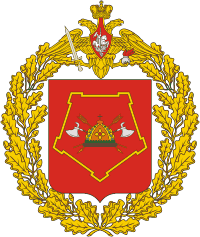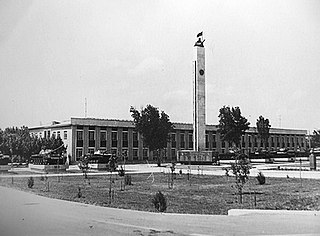Related Research Articles

Sergey Semyonovich Biryuzov was a Marshal of the Soviet Union and Chief of the General Staff.

Filipp Sergeyevich Oktyabrsky was a Soviet naval commander. He began service in the Baltic Fleet in 1918. From 1925–27 he studied at the Naval Academy in Leningrad. As vice-admiral he was given command of the Black Sea Fleet in March 1939 and headed its actions during the Sieges of Sevastopol (1941-1942) and Odessa (1941). After the war he became a Deputy Commander-in-Chief of the Navy, commander of all naval test centres and from 1957 to 1960 head of the Black Sea Higher Naval Institute "Admiral Pavel Nakhimov" in Sevastopol.

The Leningrad Military District was a military district of the Armed Forces of the Russian Federation. In 2010 it was merged with the Moscow Military District, the Northern Fleet and the Baltic Fleet to form the new Western Military District.

The Siberian Military District was a Military district of the Russian Ground Forces. The district was originally formed as a military district of the Russian Empire in 1864. In 1924 it was reformed in the Red Army. After the end of World War II the district was split into the Western and Eastern Siberian Military Districts. In 1956 the district was reformed. In 2010 it was divided between the two newly formed Central and Eastern Military Districts.

There existed an evolved system of military education in the Soviet Union that covered a wide range of ages. The Soviet Armed Forces had many tri-service educational opportunities as well as educational institutions for the Ground Forces, the Air Forces, and the Navy. The Soviet Border Troops, the KGB and the Internal Troops also maintained service academies.

The Nakhimov Naval School or Nakhimov School is a form of military education for teenagers introduced in the Soviet Union and once also located in other cities. They are named after Imperial Russian admiral Pavel Nakhimov.

Sergei Matveevich Shtemenko was a Soviet general who served as the Chief of the Soviet Armed Forces' General Staff from 1948 to 1952.

The Riga Nakhimov Naval School is one of the former Nakhimov Naval Schools in the Soviet Union. It existed from 1945 to 1953 in Riga, the capital Latvian SSR, where it was located. Throughout its eight year existence, it operated from the building that is now the Latvian War Museum.

The Sagadat Nurmagambetov Military Institute of the Kazakh Ground Forces, formerly known as the Alma-Ata Higher Combined Arms Command School – is one of the leading educational institutions in the military education system of the Kazakh Ground Forces. The military academy is based in Almaty, Kazakhstan.

The Tallinn Higher Military-Political Construction School was one of the military academies of the Soviet Union. In the years it existed, it trained military personnel in a number of specializations. It was located in Tallinn, which was the capital of the former Estonian SSR.

The Moscow Higher Combined Arms Command School "Supreme Soviet of the RSFSR" is a higher military educational institution of the Russian Armed Forces.

The Chirchiq Higher Tank Command and Engineering School, formerly the Tashkent Order of Lenin Higher Tank Command School named after Pavel Rybalko is a military academy of the Ministry of Defense of Uzbekistan, responsible for training armored and engineering personnel of the Uzbekistan Ground Forces.

The Syzran Higher Military Aviation School is a military academy of the Russian Air Force, responsible for training airmen of the Russian Armed Forces. It is a branch of the Zhukovsky – Gagarin Air Force Academy.

LVVPU, was a football team based in Lviv, Ukrainian SSR.

The Marshal of the Soviet Union K. K. Rokossovsky Far Eastern Higher Combined Arms Command School, also known by its abbreviation DVOKU, is a military academy of the Russian Armed Forces.

The Azerbaijan Higher Naval Academy is an educational institution of the Azerbaijani Naval Forces. It is part of the education system of the Ministry of Defense of Azerbaijan. It was originally founded in 1939 In Soviet times, it was called the Caspian Higher Naval Red Banner School named after Sergei Kirov.
The Minsk Higher Military-Political Combined Arms School (MVVPOU) was a specialized military higher educational institution of the Soviet Army based in the Byelorussian Soviet Socialist Republic. Located on Kalinovsky Street in Minsk, it served as part of the educational systems for both the Soviet Ministry of Defense and briefly the Ministry of Defence of Belarus.

The Makarov Pacific Higher Naval School is one of the Russian Navy's two higher educational institutions under the Ministry of Defense of Russia, with this school being located in Vladivostok in Eastern Russia, the only naval educational institution in this region. It serves as an naval officer commissioning school for officers in the Pacific Fleet. It is named after the accomplished Russian oceanographer and commander of the Imperial Russian Navy, Vice-Admiral Stepan Makarov.

The Samarkand Higher Military Automobile Command School is a military academy of the Armed Forces of the Republic of Uzbekistan and a former educational institution under the Soviet Defence Ministry.

The Main Political Directorate of the Soviet Army and Soviet Navy was the central [military]-political organ of administration in the Soviet Armed Forces in 1919 through 1991 and controlled by the Communist Party of the Soviet Union.
References
- ↑ "The High Military-Political School named by marshal S.S.Biryuzov —".
- ↑ Scott, Harriet Fast; Scott, William F. (16 July 2019). The Armed Forces of the Ussr. ISBN 9781000314748.
- ↑ Высшее военно-политическое училище им. С.С.Бирюзова в Риге
- ↑ http://www.periodika.lv/periodika2-viewer/view/index-dev.html#panel:pp%7Cissue:/g_001_0309005114%7Carticle:DIVL73%7Cquery:ASV
- ↑ "Riga Higher Military Political School".
- ↑ "Начальники Училища".
- ↑ "Дицкий Григорий Филиппович (1918-2006)".
- ↑ "Выпускники адмиралы и генералы".
- ↑ "Military Thought". 2009.
- ↑ "85 лет Училищу".